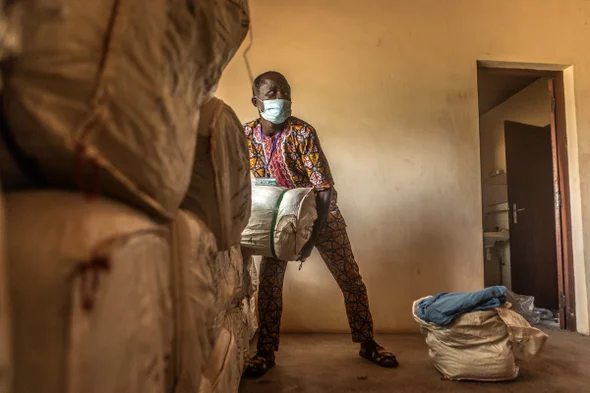A New Strain of Drug-Resistant Malaria Has Sprung Up in Africa: Here’s How We Fight Back
A New Strain of Drug-Resistant Malaria Has Sprung Up in Africa: Here’s How We Fight Back
By Thomas Hall. This article was originally published in Scientific American.

Ever since the deadly parasite responsible for malaria was discovered in the late 19th century, science and global health experts have been waging a vigorous Sisyphean battle against the disease it causes. Humans have brought an arsenal of tools—nets, rapid tests, medication—to bear against the mosquito-borne parasite, which cannily mutates to become resistant to drug treatments. We’re holding our own: Global malaria deaths declined to 409,000 in 2019, compared to 585,000 in 2010, and a number of countries have eliminated it altogether or are on the verge of doing so.
However, more than 90 percent of the deaths occur in Africa, and there is a threat that could set progress back again. Researchers in Rwanda identified a strain of the malaria parasite P. falciparum with mutations on a gene known as K13 that enable resistance to artemisinin, the foundation of artemisinin-based combination therapies (ACTs), the most commonly used malaria treatments. While ACTs still work, a weakened treatment regimen could lead to more deaths on the continent, an increased spread of resistance itself, and loss of confidence in malaria treatment.
We must act now to increase surveillance and monitoring for signs of new K13 mutations, even as we battle the COVID-19 pandemic. In addition to basic tactics like increasing people’s access to insecticide-treated mosquito nets, here’s what can help make a difference:
Ensure that providers and patients use drugs effectively
When providers don’t prescribe treatments correctly or their patients don’t take the complete course as prescribed, it contributes to the emergence of drug-resistant malaria parasites. Governments and global health programs need to reinforce effective, safe prescribing and appropriate use of ACTs. For example, largely through USAID-funded initiatives, Management Sciences for Health supports malaria case management in Benin, Madagascar, Malawi, and Nigeria. The program trains, mentors and evaluates health care providers on the use of national malaria treatment guidelines.
Take action today to maximize the longevity of ACTs
The battle to delay artemisinin drug resistance must be fought on two fronts. The first is to support the use of quality-assured medicines at the correct dosage and to continually monitor their therapeutic efficacy against any emerging signs of resistance. The second is to support national malaria programs to adopt and deploy more than one artemisinin-based treatment, such as second-line or even multiple first-line therapies along with the addition of single low-dose primaquine to help block the transmission of resistant parasites, in line with WHO guidance. Strategies such as adding a third drug to an ACT—forming a triple ACT, or TACT—are also being investigated. Finally, we need to acknowledge that the sun may be setting on today’s drugs. It may be a long sunset, but we need to be ready for tomorrow.
Develop the next generation of treatments
Medicines for Malaria Venture (MMV), a not-for-profit research and development organization, and its research and pharma partners have developed the largest portfolio of antimalarials in history. The most advanced new antimalarial medicine targeting parasites showing resistance to current drugs is in development with Swiss health care company Novartis. It’s currently in clinical trials and is aimed at treating children as young as six months, as malaria kills more children under five than any other age group. National malaria control programs must be ready to incorporate this potential new medicine in their budgets and treatment guidelines when it becomes available.
Expand lab testing capacity
Improved surveillance to track the spread of resistant plasmodia is critical to maintaining progress, including using molecular and genomic techniques. However, many sub-Saharan African countries do not yet have the equipment, personnel, funding or infrastructure to efficiently handle sequencing for malaria. Here, too, investors and collaborators must strengthen and build additional capacity. The National Institutes of Health and the Wellcome Trust have established the Human Heredity and Health in Africa (H3Africa) initiative to build capacity on the continent, as is the U.S. President’s Malaria Initiative–supported Antimalarial Resistance Monitoring in Africa Network, which also supports collaborative efforts across the continent. The Africa CDC and the African Academy of Sciences have provided funding. Yet much more is needed for sufficient lab capacity.
Develop a cross-border action plan with neighboring countries
Now that resistant parasites have been documented in Rwanda, they may be carried by travelers across borders or may already be in other African countries. National malaria control programs and WHO’s regional and country offices need to reinforce intercountry collaboration, sharing information as well as educating health care providers and communities about the implications of the mutation. Pharmaceutical regulatory agencies should continue to monitor and enforce quality standards to prevent and tackle substandard and falsified medicines, which greatly contribute to drug resistance. The West African Health Organization; Southern African Development Community; and East, Central and Southern African Health Community should work together to align efforts.
Southeast Asia has already seen this mutation as of 2013 and is holding it at bay with careful use of drugs that work where they are most needed. We can outsmart this. We must bring our collective human ingenuity and determination to ensure that the continent bearing the world’s greatest burden of malaria stays one step ahead of the emerging threat of this dangerous mutant parasite.